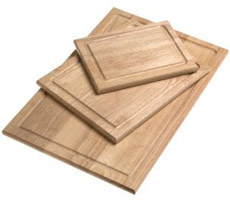TIP OF THE DAY: Prevent Cutting Boards From Slipping
|
|
Yesterday we took a cooking class at the French Culinary Institute in New York City, where we picked up this tip:
To prevent the cutting board from slipping, place a moist paper towel underneath it. If you have slippage problems, try it. When you’re done slicing and dicing, wash the cutting board and use the paper towel to wipe the counter. Cutting boards can deteriorate over time, as they develop deep knife grooves that can harbor bacteria. Then, it’s time to replace them. Rather than toss them in the trash, seek ways to repurpose them—for example, underneath houseplants, as a cutting surface for crafts and other projects, and as a surface protector when using glue. |
|
|
While wood cutting boards are traditional and handsome, wood is naturally porous. Beyond the knife grooves, which can harbor harmful bacteria, the microbes can hide in the grain of well-used cutting boards. To avoid food safety problems, health departments prohibit wood cutting boards in commercial kitchens. Instead of wood, select acrylic cutting boards. We use these cutting boards, from OXO Good Grips. Lastly, to prevent cross-contamination, you need to thoroughly wash cutting boards with soap and hot water after cutting raw meat or seafood. To address the contamination problem, some companies are producing color-coded cutting boards. But we haven’t yet seen a set that’s large enough for serious cooking. Acrylic cutting boards can go right into the dishwasher, for a thorough sanitizing.
|
||



